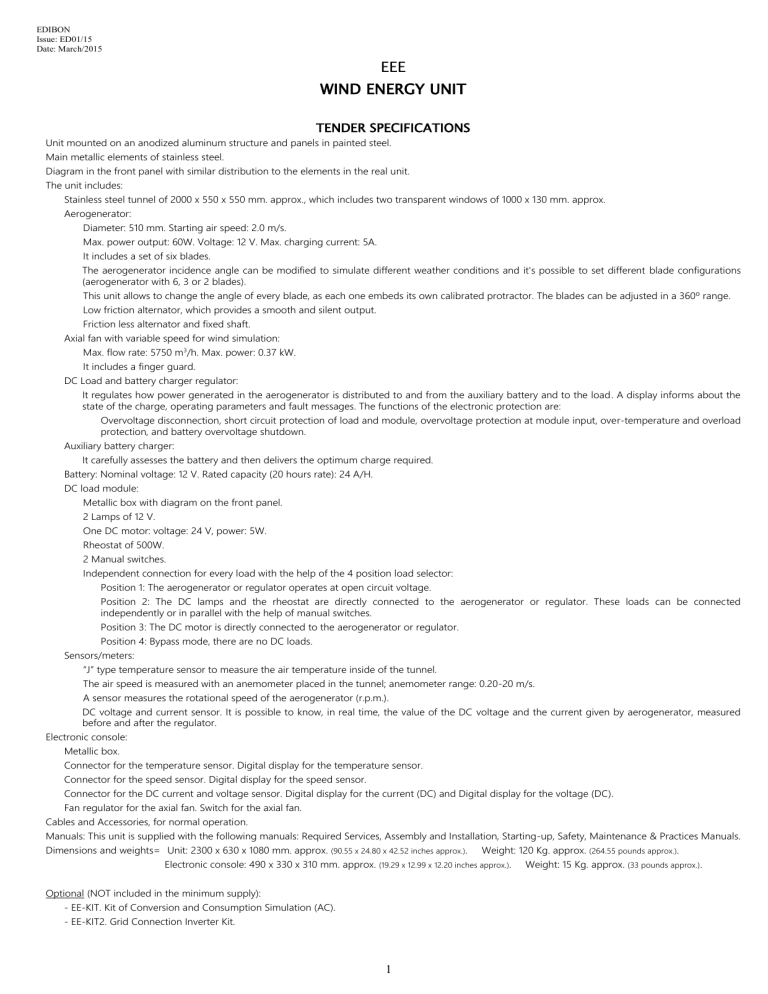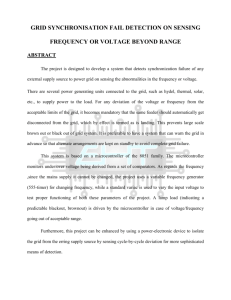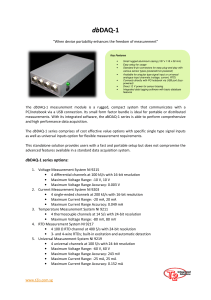EEE - Edibon

EDIBON
Issue: ED01/15
Date: March/2015
EEE
WIND ENERGY UNIT
TENDER SPECIFICATIONS
Unit mounted on an anodized aluminum structure and panels in painted steel.
Main metallic elements of stainless steel.
Diagram in the front panel with similar distribution to the elements in the real unit.
The unit includes:
Stainless steel tunnel of 2000 x 550 x 550 mm. approx., which includes two transparent windows of 1000 x 130 mm. approx.
Aerogenerator:
Diameter: 510 mm. Starting air speed: 2.0 m/s.
Max. power output: 60W. Voltage: 12 V. Max. charging current: 5A.
It includes a set of six blades.
The aerogenerator incidence angle can be modified to simulate different weather conditions and it's possible to set different blade configurations
(aerogenerator with 6, 3 or 2 blades).
This unit allows to change the angle of every blade, as each one embeds its own calibrated protractor. The blades can be adjusted in a 360º range.
Low friction alternator, which provides a smooth and silent output.
Friction less alternator and fixed shaft.
Axial fan with variable speed for wind simulation:
Max. flow rate: 5750 m 3 /h. Max. power: 0.37 kW.
It includes a finger guard.
DC Load and battery charger regulator:
It regulates how power generated in the aerogenerator is distributed to and from the auxiliary battery and to the load. A display informs about the state of the charge, operating parameters and fault messages. The functions of the electronic protection are:
Overvoltage disconnection, short circuit protection of load and module, overvoltage protection at module input, over-temperature and overload protection, and battery overvoltage shutdown.
Auxiliary battery charger:
It carefully assesses the battery and then delivers the optimum charge required.
Battery: Nominal voltage: 12 V. Rated capacity (20 hours rate): 24 A/H.
DC load module:
Metallic box with diagram on the front panel.
2 Lamps of 12 V.
One DC motor: voltage: 24 V, power: 5W.
Rheostat of 500W.
2 Manual switches.
Independent connection for every load with the help of the 4 position load selector:
Position 1: The aerogenerator or regulator operates at open circuit voltage.
Position 2: The DC lamps and the rheostat are directly connected to the aerogenerator or regulator. These loads can be connected independently or in parallel with the help of manual switches.
Position 3: The DC motor is directly connected to the aerogenerator or regulator.
Position 4: Bypass mode, there are no DC loads.
Sensors/meters:
“J” type temperature sensor to measure the air temperature inside of the tunnel.
The air speed is measured with an anemometer placed in the tunnel; anemometer range: 0.20-20 m/s.
A sensor measures the rotational speed of the aerogenerator (r.p.m.).
DC voltage and current sensor. It is possible to know, in real time, the value of the DC voltage and the current given by aerogenerator, measured before and after the regulator.
Electronic console:
Metallic box.
Connector for the temperature sensor. Digital display for the temperature sensor.
Connector for the speed sensor. Digital display for the speed sensor.
Connector for the DC current and voltage sensor. Digital display for the current (DC) and Digital display for the voltage (DC).
Fan regulator for the axial fan. Switch for the axial fan.
Cables and Accessories, for normal operation.
Manuals: This unit is supplied with the following manuals: Required Services, Assembly and Installation, Starting-up, Safety, Maintenance & Practices Manuals.
Dimensions and weights= Unit: 2300 x 630 x 1080 mm. approx.
(90.55 x 24.80 x 42.52 inches approx.)
. Weight: 120 Kg. approx.
(264.55 pounds approx.)
.
Electronic console: 490 x 330 x 310 mm. approx.
(19.29 x 12.99 x 12.20 inches approx.)
. Weight: 15 Kg. approx.
(33 pounds approx.)
.
Optional (NOT included in the minimum supply):
- EE-KIT. Kit of Conversion and Consumption Simulation (AC).
- EE-KIT2. Grid Connection Inverter Kit.
1
EDIBON
Issue: ED01/15
Date: March/2015
EEE
WIND ENERGY UNIT
Optional
EE-KIT. Kit of Conversion and Consumption Simulation (AC):
Single-phase inverter:
Single-phase.
25 kHz switch mode technology.
Start-up power of 200%.
Short-circuit protection.
High temperature protection.
Overcharge protection.
Operation state indicating LED.
Rear connection/disconnection switch.
AC Loads Module:
Metallic box.
Diagram in the front panel.
Axial compact fan of 230V with plastic guards.
3 Lamps of 220V - 240V., power: 11W.
Independent connection for every load with the help of the 4 positions selector:
- Inverter operation with no load.
- Fan motor connected.
- One AC lamp connected.
- Two AC lamps connected in parallel.
AC voltage and current sensor. The value of AC power can be visualized with the software.
EE-KIT2. Grid Connection Inverter Kit:
Inverter used for the conversion and injection to the grid of the power generated by a simulated source of renewable energy. The simulated source is a simulator used to obtain a variable power to be injected to the grid.
The operation mode is displayed by means of an indicating LED at the front side of the housing.
It is equipped with extensive safety measures to ensure that it is immediately switched off as soon as the AC plug is removed from the wall socket or the operation of the public grid fails.
The inverter can be connected to a computer (PC) through a RS232 communication to display some parameters, such as voltage and current inputs, mains voltage and frequency, maximum AC power, kWh, etc.
Grid Connection Inverter:
Input (DC):
Nominal power @ 25ºC: 150 W.
Maximum power @ 25ºC: 220 W.
MPP voltage: 45-125V DC.
Maximum voltage: 155V DC.
Nominal current: 3A.
Output (AC):
Voltage: 230V (207 - 253 V).
Maximum power, fuse: 2.25 A.
Frequency: 50 Hz (49.8 ~ 50.2 Hz).
This unit is supplied with the Grid Simulator (ESR), which simulates a low power grid to inject the power generated by the inverter.
Grid Simulator (ESR):
ESR is designed to create an isolated low power grid. The unit uses a battery as voltage source and generates a sine signal of 220V/50Hz. The main features of the ESR are:
Inlet voltage source: battery of 12Vdc.
Output: 220V/50Hz.
Isolation transformer.
Battery charger included.
Protection fuses.
The user can work with this module safely. The devices included in the EE-KIT2 can be used worldwide.
2
EDIBON
Issue: ED01/15
Date: March/2015
EEE
WIND ENERGY UNIT
EXERCISES AND PRACTICAL POSSIBILITIES
1.- Identification and familiarization with all components of the unit and how they are associated with its operation.
2.- Familiarization with the regulator parameters and the wind energy measurements.
3.- Study of the conversion of kinetic wind energy into electrical energy.
4.- Study of the power generated by the aerogenerator depending on the wind speed.
5.- Determination of the typical parameters of the aerogenerator (short circuit current, open-circuit voltage, maximum power).
6.- Determination of the I-V curve.
7.- Study of voltage, current and power in function of different loads.
8.- Study of the influence of the load variation on the aerogenerator.
9.- Determination of the maximum power output of the aerogenerator.
10.-Determination of the P-air speed curve.
11.-Study of the power generated by the aerogenerator depending on the incident angle of the air.
12.-Study of the characteristic curve of the rotor.
13.-Study of the connection of loads to direct voltage.
Additional practical possibilities:
14.-Study of the power coefficient.
15.-Study of the aerogenerator operation in function of the blade configuration (aerogenerator with 6, 3 or 2 blades).
16.-Study of the optimum number of blades.
17.-Study of the aerogenerator operation in function of the angle of the blades.
18.-Study of the efficiency of a wind power unit.
19.-Determination of the efficiency of a wind power unit in function of the number of blades, angle of the blades and angle of the generator.
Practices to be done with the OPTIONAL KIT “EE-KIT”:
20.-Study of the connection of loads to alternating voltage of 220V.
Practices to be done with the OPTIONAL KIT “EE-KIT2”:
21.-Study of the inverter connected to the grid simulator.
3





